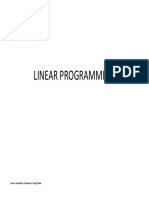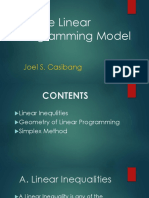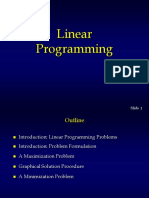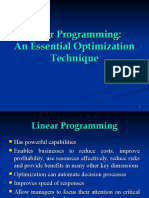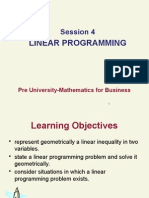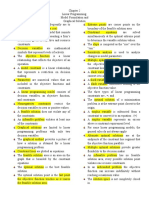0 ratings0% found this document useful (0 votes)
49 viewsLinear Programming: Asst. Prof. Antonette C. Torreda, Ed.D Ust-Amv College of Accountancy
1) Define the decision variables and objective function
2) Graph the constraints to determine the feasible region
3) Identify the extreme points and test which yields the maximum objective value
4) The optimal solution is 2 gowns and 3 cocktail dresses for a maximum profit of P6,000
Uploaded by
artCopyright
© © All Rights Reserved
Available Formats
Download as PDF, TXT or read online on Scribd
0 ratings0% found this document useful (0 votes)
49 viewsLinear Programming: Asst. Prof. Antonette C. Torreda, Ed.D Ust-Amv College of Accountancy
1) Define the decision variables and objective function
2) Graph the constraints to determine the feasible region
3) Identify the extreme points and test which yields the maximum objective value
4) The optimal solution is 2 gowns and 3 cocktail dresses for a maximum profit of P6,000
Uploaded by
artCopyright
© © All Rights Reserved
Available Formats
Download as PDF, TXT or read online on Scribd
You are on page 1/ 23
LINEAR PROGRAMMING
ASST. PROF. ANTONETTE C. TORREDA, Ed.D
UST-AMV COLLEGE OF ACCOUNTANCY
Sources: Quantitative Techniques by Sirug/Tabuloc
Methods of solving simple Linear
Programming:
Graphic Method or Geometric Method
Simplex Method or Tabular Method
Programming uses steps or procedures in order
to come up with a correct decision or best
answers in a programming problem.
• What must be the maximum income x in order
to belong to the upper 50% of the group?
• What must be the maximum volume of a box
that is to be made from a piece of cardboard?
• How many number of students must be
enrolled in a class in order the section will not
be dissolved?
• What is the shortest distance a delivery boy
should travel in order to come on time?
LINEAR PROGRAMMING: GRAPHICAL
METHOD
Terminologies:
Linear
• Refers to the relationship involving two or
more variables which show first-degree
mathematical statement.
• The graph of a linear equation is a
straight line.
• The graph of inequality is a half-plane.
Programming
• Refers to the use of certain mathematical
techniques or algorithms to obtain best
possible solution or the optimal solution.
Linear Programming
• is a branch of applied mathematics, which is
a mathematical technique that involves
maximizing and minimizing a linear function
subject to given linear constraints.
• is a method of dealing with decision
problems that can be expressed as
constrained linear models.
• is a mathematical technique for finding the
best uses of an organization’s resources.
Inequality
• is a mathematical statement describing
that one expression or quantity is not of
equal value with another expression or
quantity.
Graphical Solution Method
• is a two-dimensional geometric analysis
of Linear Programming problems with two
decision variables, x and y.
Decision Variables
• Are variables that correspond to the
decision that must be made in order to
identify a solution to the problem.
x be the number of bottles of softdrinks
x be the number of alcoholic beverages
z be the number of desk top
w be the number of laptops
x be the tablets
Characteristics of Linear Programming
Problem:
1. Objective Function
• is an expression, which shows the
relationship between the variables in the
problem and the firm’s goal.
• is a mathematical statement reflecting the
objective of the operation(problem).
• The objective of the decision maker must be
to maximize or minimize.
• Maximization problem involves profit,
market share, revenue, sales, production,
etc.
• Minimization involves cost, distance, time,
worker, etc.
2. Constraints
• are referred to the availability of resources like labor
time, machine time, raw materials, work or storage
space, etc.
• There are two kinds of constraints:
1. Structural Constraint
also called explicit constraints
are the conditions stated in the problem.
is a limit on the availability of resources.
2. Non-negativity constraint
also called implicit constraints.
States that the variables are always greater than or
equal to zero such as the number of units
produced, number of hours, area, distance,
volume, etc.
Example:
A construction firm got a new project from the DPWH to provide them
maximum number of concrete barriers and drainage lid for a period of one
week. The firm has 980 units of steel slabs available while there are 500
units of cement mixture available. A concrete barrier needs 3 units of steel
slabs and 2 units of cement mixture while a drainage lid needs 2 units of
steel slabs and 1 unit of cement mixture. If the firm set P2000.00 per
concrete barrier and P1000.00 per drainage lid, what is the maximum
income that the firm will collect from the DPWH after the project?
Example:
A construction firm got a new project from the DPWH to provide
them maximum number concrete barriers and drainage lid for a period of
one week. The firm has 980 units of steel slabs available while there are
500 units of cement mixture available. A concrete barrier needs 3 units of
steel slabs and 2 units of cement while a drainage lid needs 2 units of steel
slabs and 1 unit of cement mixture. If the firm set P2000.00 per concrete
barriers and P1000.00 per drainage lid, what is the maximum income that
the firm will collect from the DPWH after the project?
Let x = number of concrete barriers
y = number of drainage lid
Objective Function: P = 2000X + 1000Y
Constraints:
Available
3X + 2Y ≤ 980 X Y
Resources
2X + Y ≤ 500 Steel slabs 3 2 980
X ≥ 0, Y ≥ 0 Cement
2 1 500
mixture
Price per unit 2000 1000
Non negativity constraints:
x1, x2, x3, …xn ≥ 0
Non negativity constraints:
x1, x2, x3, …xn ≥ 0
Words or expressions to denote ≤ are:
“no more than”, “available”, “at most”,
“limited to”, etc.
For ≥ :
“at least”, “more than”, “exceed”,
”minimum”, etc.
Feasible Region
• is the set of combination of values for the
decision variables that satisfy the non-
negativity conditions and all the
constraints simultaneously, that is, the
allowable decisions.
• The common intersection of the graphical
solutions of the problem constraints.
• The solution may be a plane figure or a
segment and the corner/end points of this
figure can be determined.
The feasible region may be bounded or
unbounded:
• Bounded if the region is a closed plane
figure.
• Unbounded if the region is an open plane
figure.
Infeasible
• An LPP has an infeasible solution if the
solutions of the problem constraints do
not intersect, that is, no feasible solution
is formed.
• There is no common region that satisfies
the given constraints.
Extreme Point
• is the corner of the feasible region.
• if a Linear Programming problem has a
solution, there is always at least one
extreme point solution.
Optimal Solution
• is a combination of decision variable
amounts that yields the best possible
value of the objective function and
satisfies all the constraints.
• there may be multiple combinations of
decision variables that yield the same
best value of the objective function.
Multiple solution
Steps of Linear Programming using the Graphical Method:
1. Determine the decision variables in the problem, and
then represent them using variable letters.
2. Form the LP model.
a) Objective function
b) The structural constraints
3. Graph the problem constraints and determine the
feasible region.
4. Find the extreme/corner points of the feasible region.
One or more of the extreme/corner point of the feasible
region is the solution of the problem, which is the
optimal solution of the problem (or the optimal
extreme/corner point).
5. Test each extreme/corner point of the feasible region to
see which yields the maximum or minimum amount of
the objective function.
Maximization Problem
Illustration 1.
A couturier has the following materials
available: 18 square meter sateen, 20 square
meter Lace, and 5 square meter chiffon. A gown
requires the following: 3 square meter sateen, 2
square meter lace, and 1 square meter chiffon. A
cocktail dress requires the following: 2 square
meter sateen, and 4 square meter lace. If a gown
sells for P1,200 and a cocktail dress sells P1,600,
how many of each garments should the couturier
make to obtain the maximum amount of money?
Let x = be the number of gowns
y = be the number of cocktail dress
x gowns y cocktail dresses Resources
Sateen 3 2 18
Lace 2 4 20
Chiffon 1 5
cost P1200 P1600
Objective Function: Max P = 1200x +1600y
Constraints:
3x +2y ≤ 18 (Sateen constraints)
2x +4y ≤ 20 (Lace constraints)
x ≤5 (Chiffon constraints)
x, y ≥ 0 (non-negativity constraints)
You might also like
- PrelimChapter2LinearProgrammingBasicConceptsMY PDFNo ratings yetPrelimChapter2LinearProgrammingBasicConceptsMY PDF40 pages
- Linear Programming: Sources: Quantitative Techniques by Sirug/TabulocNo ratings yetLinear Programming: Sources: Quantitative Techniques by Sirug/Tabuloc48 pages
- Application of Graphical Method in Real LifeNo ratings yetApplication of Graphical Method in Real Life15 pages
- Simple Linear Programming Model: Joel S. CasibangNo ratings yetSimple Linear Programming Model: Joel S. Casibang49 pages
- Mathematics in The Modern World - Finals - ReviewerNo ratings yetMathematics in The Modern World - Finals - Reviewer19 pages
- 4_Module 4_Unit 3_Linear Programming Models_2037274932No ratings yet4_Module 4_Unit 3_Linear Programming Models_203727493232 pages
- Linear Programming - The Graphical MethodNo ratings yetLinear Programming - The Graphical Method6 pages
- 010 LP - Formulation & Graphical MethodsNo ratings yet010 LP - Formulation & Graphical Methods22 pages
- Management Science Lecture 2 Graphical MethodNo ratings yetManagement Science Lecture 2 Graphical Method12 pages
- Linear Programming: An Essential Optimization TechniqueNo ratings yetLinear Programming: An Essential Optimization Technique43 pages
- PAN African e Network Project: Semester - 1No ratings yetPAN African e Network Project: Semester - 175 pages
- Chapter Two Introduction To Linear ProgrammingNo ratings yetChapter Two Introduction To Linear Programming62 pages
- Linear Programming: by Nagendra Bahadur Amatya Head of DepartmentNo ratings yetLinear Programming: by Nagendra Bahadur Amatya Head of Department29 pages
- Linear Programmin G: by Nagendra Bahadur Amatya Head of DepartmentNo ratings yetLinear Programmin G: by Nagendra Bahadur Amatya Head of Department29 pages
- Linear Programming Basic Concepts and Graphical SolutionsNo ratings yetLinear Programming Basic Concepts and Graphical Solutions7 pages
- Management Science Tools: Linear ProgrammingNo ratings yetManagement Science Tools: Linear Programming12 pages
- EContent 3 2024 09 18 17 33 13 Session416LinearProgrammingIntroduction2ppt 2024 08 16 14 07 54No ratings yetEContent 3 2024 09 18 17 33 13 Session416LinearProgrammingIntroduction2ppt 2024 08 16 14 07 5440 pages
- Chapter 2 (Part 1) Linear Programming (Formulation & Graphical Method)No ratings yetChapter 2 (Part 1) Linear Programming (Formulation & Graphical Method)47 pages
- Operations Research Question Bank 24-25 -Tybms (Core)-InternalNo ratings yetOperations Research Question Bank 24-25 -Tybms (Core)-Internal1 page
- Deterministic Finite Automata and Turing MachineNo ratings yetDeterministic Finite Automata and Turing Machine4 pages
- An Intuitive Guide To Numerical Methods Heinold PDFNo ratings yetAn Intuitive Guide To Numerical Methods Heinold PDF121 pages
- Addition of Two Polynomials Using Linked ListNo ratings yetAddition of Two Polynomials Using Linked List15 pages
- Chapter One:data Structures and Algorithm AnalysisNo ratings yetChapter One:data Structures and Algorithm Analysis209 pages
- Information Theory For Electrical EngineersNo ratings yetInformation Theory For Electrical Engineers277 pages
- Matlab Optimization Toolbox: Most Materials Are Obtained From Matlab WebsiteNo ratings yetMatlab Optimization Toolbox: Most Materials Are Obtained From Matlab Website12 pages
- Programming in Haskell: Chapter 7 - Higher-Order FunctionsNo ratings yetProgramming in Haskell: Chapter 7 - Higher-Order Functions24 pages
- PrelimChapter2LinearProgrammingBasicConceptsMY PDFPrelimChapter2LinearProgrammingBasicConceptsMY PDF
- Linear Programming: Sources: Quantitative Techniques by Sirug/TabulocLinear Programming: Sources: Quantitative Techniques by Sirug/Tabuloc
- Mathematics in The Modern World - Finals - ReviewerMathematics in The Modern World - Finals - Reviewer
- 4_Module 4_Unit 3_Linear Programming Models_20372749324_Module 4_Unit 3_Linear Programming Models_2037274932
- Linear Programming: An Essential Optimization TechniqueLinear Programming: An Essential Optimization Technique
- Linear Programming: by Nagendra Bahadur Amatya Head of DepartmentLinear Programming: by Nagendra Bahadur Amatya Head of Department
- Linear Programmin G: by Nagendra Bahadur Amatya Head of DepartmentLinear Programmin G: by Nagendra Bahadur Amatya Head of Department
- Linear Programming Basic Concepts and Graphical SolutionsLinear Programming Basic Concepts and Graphical Solutions
- EContent 3 2024 09 18 17 33 13 Session416LinearProgrammingIntroduction2ppt 2024 08 16 14 07 54EContent 3 2024 09 18 17 33 13 Session416LinearProgrammingIntroduction2ppt 2024 08 16 14 07 54
- Chapter 2 (Part 1) Linear Programming (Formulation & Graphical Method)Chapter 2 (Part 1) Linear Programming (Formulation & Graphical Method)
- Mathematical Optimization: Fundamentals and ApplicationsFrom EverandMathematical Optimization: Fundamentals and Applications
- Operations Research Question Bank 24-25 -Tybms (Core)-InternalOperations Research Question Bank 24-25 -Tybms (Core)-Internal
- An Intuitive Guide To Numerical Methods Heinold PDFAn Intuitive Guide To Numerical Methods Heinold PDF
- Chapter One:data Structures and Algorithm AnalysisChapter One:data Structures and Algorithm Analysis
- Matlab Optimization Toolbox: Most Materials Are Obtained From Matlab WebsiteMatlab Optimization Toolbox: Most Materials Are Obtained From Matlab Website
- Programming in Haskell: Chapter 7 - Higher-Order FunctionsProgramming in Haskell: Chapter 7 - Higher-Order Functions

